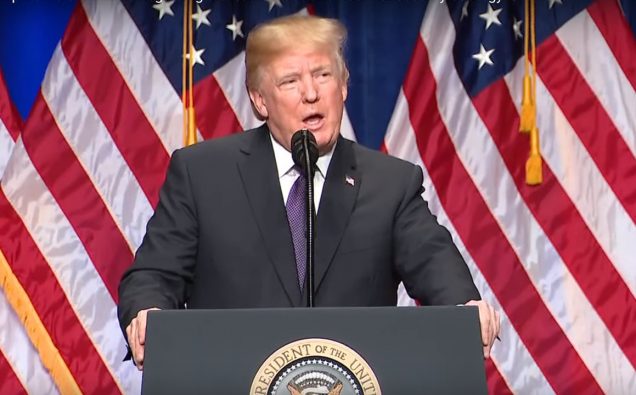
President Trump may have come empty-handed from a meeting with North Korea leader over denuclearization of the Korean Peninsula but his administration is focused intently on containing a crisis between two South Asian nuclear powers Pakistan and India.
And the stakes are so high that failure is not an option, as reflected by President Trump’s latest remarks on the exacerbating South Asian scenario.
“We have I think reasonably attractive news from Pakistan and India,” the U.S. president said in Hanoi, Vietnam Thursday while commenting on the precarious Pakistan-India situation since a February 14 militant attack killed 40 Indian security personnel.
“They have been going at it and we have been involved in trying to have them stop and we have some reasonably decent news hopefully that will be coming to an end,” Trump noted amid fallout of the conflict reaching far beyond the region with impact on stock markets and a cloud over economic prospects.
Over the past two weeks, New Delhi has escalated both the war of words and military actions its neighbor Pakistan, blaming Islamabad for the attack claimed by a Jaish e Mohammad militant outfit.
Trump’s comments are his second public statement since the outbreak of hostilities between Pakistan and India, who have fought several wars and conflicts over Kashmir, considered a major cause of militancy in the region. Secretary of State Mike Pompeo has spoken to foreign ministers of both countries. The Pentagon is also watching the situation closely.
Washington’s diplomatic drive at conflict-management stems from an array of considerations, a nuclear conflagration and Afghanistan being among the key priorities. After almost 18 years of 9/11-triggered war in Afghanistan, the U.S. is sees real possibility of a political settlement to the conflict. Pakistan is playing a critical role by influencing the Afghan Taliban into reconciliation talks.
Trump has acknowledged Islamabad’s role and also noted that his administration has now ‘much better’ relations with Pakistan than previous years.
On the other hand, analysts in Washington view India as a counterweight to fast-rising China, the second biggest economy and now a major international player. National Security Advisor John Bolton’s statement that India had a right to self-defense in the aftermath of the February 14 militant attack has been interpreted as a big sign of support for Indian counterterrorism moves.
But both Pakistan and India have long seen their relations with the United States as a zero-sum game, making Washington’s task much harder. Besides, both backed proxies during the 1990s in Afghanistan.
Yet, the situation in 2019 is different from previous occasions, when Pakistan and India went to the brink of conflict and Washington played the broker for peace.
Indian Prime Minister Modi has changed the situation dramatically with both rhetoric and a daring incursion into Pakistani territory, pushing the region into a far more dangerous situation than 2002 and 2008 Pakistan-India standoffs.
This week Indian jets entered the Pakistani territory, deeper than the disputed Jammu and Kashmir region, and targeted what it claimed to be a training camp of JeM in Balakot, Khyber Pakhtunkhwa.
By doing so India’s ultrantionalist Prime Minister Naredra Modi, who has the backing of several far right extremist groups, left Prime Minister Imran Khan and Rawalpindi with no option but to strike back.
The retaliation came quickly on Tuesday, when Pakistan shot down two Indian fighter jets on the Line of Control. It also captured an Indian pilot after his fighter plane was downed in Pakistan-administered side of Kashmir.
Not long after Trump’s comments Thursday, Pakistan announced that it would free the captured Indian pilot as a ‘peace gesture.’
For now, it seems that Islamabad is ready to deescalate the situation as Prime Minister Imran Khan has also reiterated his call for dialogue toward resolving thorny Pakistan-India disputes.
However, the Indian response to American diplomacy is not yet clear. A Times of India report Thursday, citing unnamed sources, said PM Modi is not ready to talk to his Pakistani counterpart until Pakistan acts against alleged terror infrastructure.
Meanwhile, China, European Union, OIC and Pakistan’s Gulf allies have also called for de-escalation of South Asian tensions.
In the past, each time Washington brokered peace between Pakistan and India – during presidents George W Bush and Barack Obama – it gained advantage in terms of American economic and defense deals and political support. Even this time, while President Trump’ statements reflect a balancing act, Secretary Pompeo’s statement calling for restraint, largely appears to back the Indian line.
But for now, the U.S. diplomacy means that the perennial U.S.-Pakistan-India triangular equation is back in action. President Barack Obama’s de-hyphenation of Washington’s relations with Pakistan and India – criticized by experts including Stephen Cohen – worked on some occasions but it never delivered fully. Both Pakistan and India remain at loggerheads over the unresolved Kashmir dispute.
Soon after showing its military muscle with the shooting down of Indian war planes, Pakistan has done well by taking the initiative to free the captured Indian pilot.
Having made it clear to India that any incursion into its territory has a cost, Islamabad is faced with calls to stamp out militancy. India is winning the diplomatic battle with sale of its narrative. Pakistan must carefully calibrate its diplomacy, move against any militants behind the Pulwama attacks, and convince the world of its stance that the South Asian peace is linked to a resolution of the dispute over Kashmir, where people demanding freedom have been facing Indian repression and denial of fundamental rights.
















